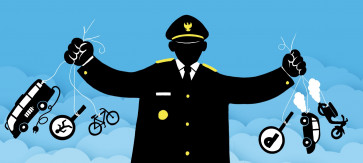Popular Reads
Top Results
Can't find what you're looking for?
View all search resultsPopular Reads
Top Results
Can't find what you're looking for?
View all search results
- -
- Fri, September 29, 2023
Change text size
Gift Premium Articles
to Anyone
Work It Right is a weekly column that provides practical and insightful advice on the complexities of urban transportation.
On Oct. 15, the “Festival Mini: Solusi Polusi Udara di Kota”, or Mini festival: Solution to Urban Air Pollution, will be held at Taman Literasi Martha C. Tiahahu.
The event will highlight the importance of policies and regulations to manage the use of motorized vehicles in solving air pollution and congestion issues. The public will be able to play a board game at the event called “Sehari Menjadi Walikota, Membangun Kota Anti Polusi dan Macet”, in which players can become mayors and have the power to determine regulations and policies that the city can implement to curb air pollution and congestion in the city.
Despite it being the only city in Indonesia to build and implement a public transportation system designed to decrease air pollution, Jakarta has recently been among the most polluted cities in the world. Policies related to public transportation are passed on from one governor to another.
This, however, is unfortunately not accompanied by consistent policies and regulations to manage the use of motorized vehicles, which are the primary source of transportation problems in Jakarta.
Based on a Statistics Indonesia (BPS) report, there were 26.37 million motorized vehicles in Jakarta in 2022 and motorbikes were the most common vehicle type, with 17.3 million units. Based on the study results, cars and motorbikes produce exhaust emissions of 3,147 µg/km/person and 1.17 µg/km/person, respectively, making them the largest emitters of exhaust emissions.
The absence of regulations to limit and control the use of motorized vehicles results in increased air pollution, and reduces available road space, meaning that Transjakarta bus lanes, sidewalks and bicycle lanes are often occupied by cars and motorcycles, resulting in suboptimal public transportation services and pedestrian and cyclist infrastructure. Furthermore, this all causes congestion to increase, accompanied by traffic accidents.
Improved management of motor vehicles is not only a solution to air pollution, but it also ensures that road space can be used by all road users, including public transportation passengers, pedestrians, cyclists and private motor vehicles. There must a price for excessive use of motor vehicles to deal with the quality-of-life decline in cities.
Being mayor for a day
As mayor during the one-hour game session, you will have the power to determine the policies and regulations in your make-believe city, to make it more livable. You will have five policy cards to determine which policies or regulations will impact air pollution and road congestion in a specific case.
Case example: There has been an increase in acute respiratory infections in your city, especially in children. What policies will you, as mayor, implement, to reduce the impacts of air pollution from the transportation sector?
In your hand, you will have a High Parking Fare card, a Build Cycling Lane card, a Work from Home card, an Urban Highway card and a Build BRT card. Every move you make can get you points for public reception, for how “green” the decision is and for positive impacts to the city. There are 16 cases on the game board to be solved, and you can play it with friends or family.
In addition to the board game, you will also be able to participate in a Low Emission Zone (LEZ) interactive installation, in which you chose an area in Jakarta to be a Low Emission Zone. In collaboration with Koalisi Berhuni untuk Semua (Kéruma), another installation will show how much space is wasted for parking, and also give examples of how this wasted space can be transformed into used more efficiently. A book review session will follow the event.
ITDP Indonesia’s director will break down the details of a comprehensive book by ITDP Indonesia called Charging Forward: The State and Challenges of Electric Bus Adoption for Public Transport in Indonesia, and get a review from Fikri Assegaf, an academic and lawyer from the AHP law firm. The event will be closed by a public discussion involving speakers from the national and city governments to discuss how the Low Emission Zone can be a powerful tool for cities to reduce air pollution.
-- Have a question about urban transportation? Send it to wir@thejakartapost.com with your name and current location (anonymous submissions will also be considered). Please note that The Jakarta Post reserves the right to edit your letters for publication
***
The writer is a senior communications and partnership manager at the Institute for Transportation and Development Policy (ITDP).
Have a question about urban transportation? Send it to wir@thejakartapost.com with your name and current location (anonymous submissions will also be considered). Please note that The Jakarta Post reserves the right to edit your letters for publication.









